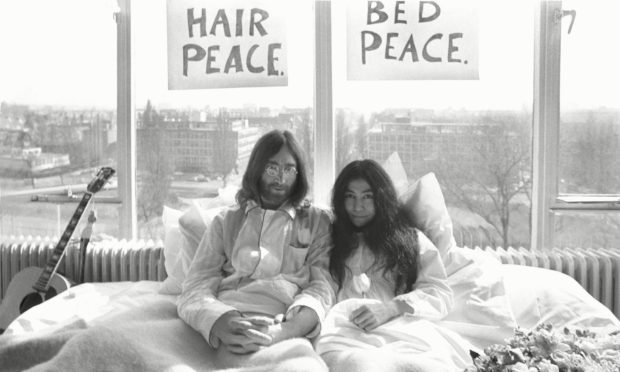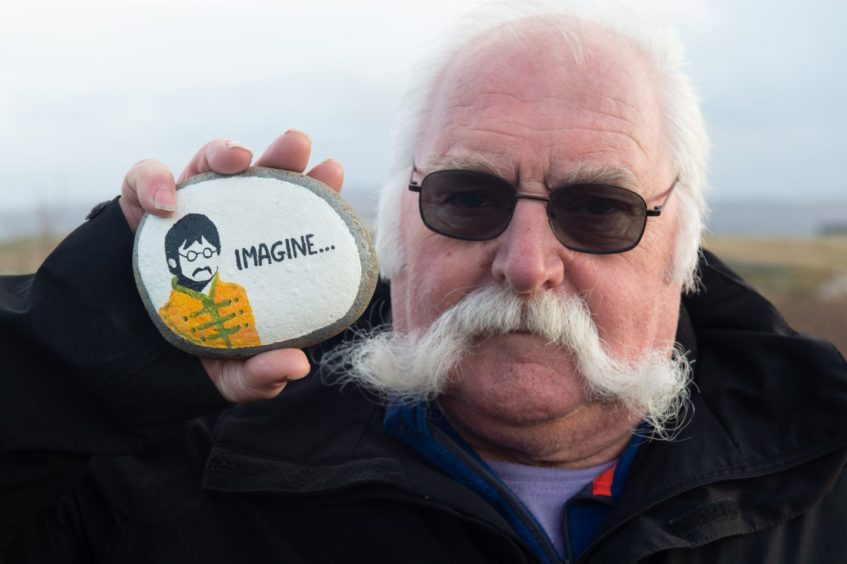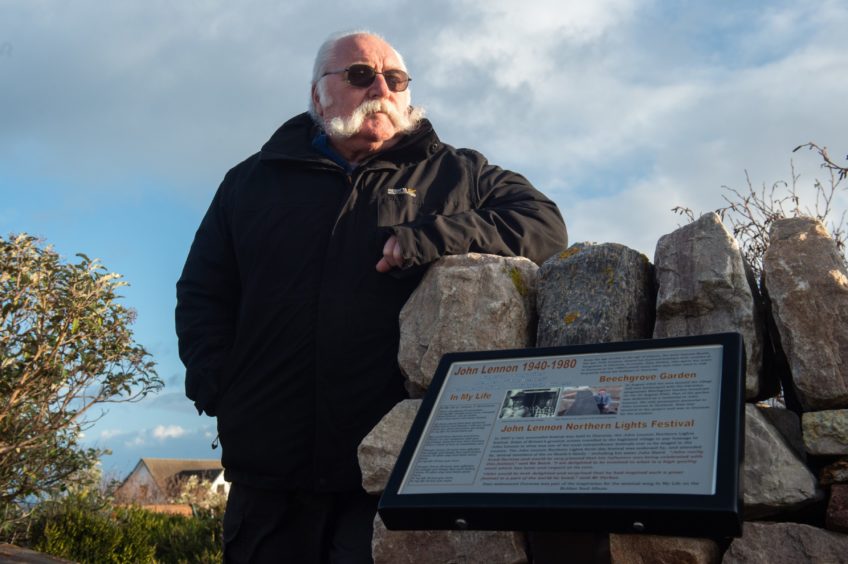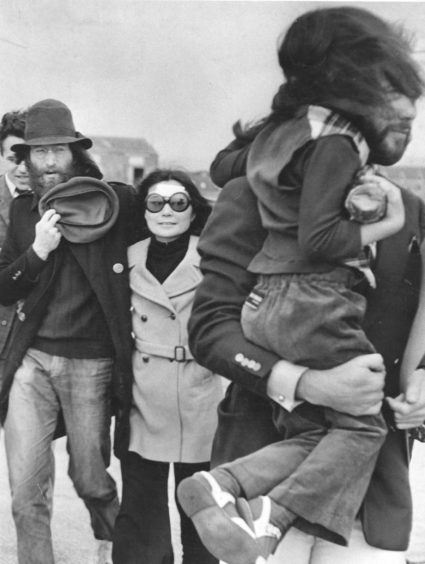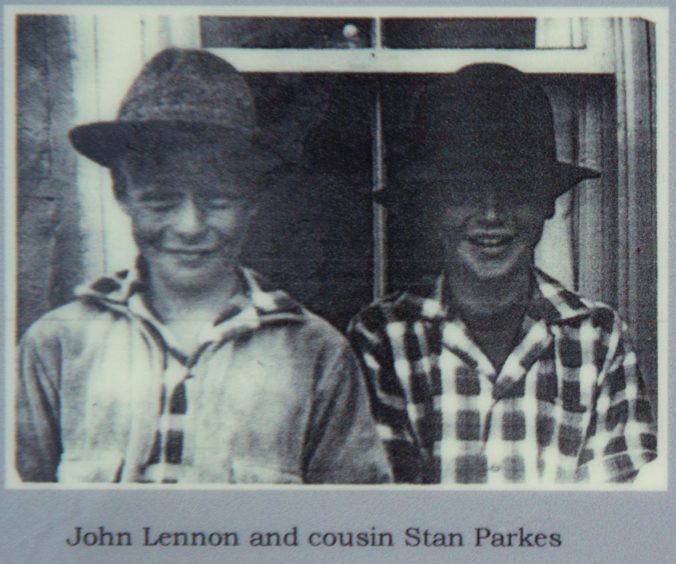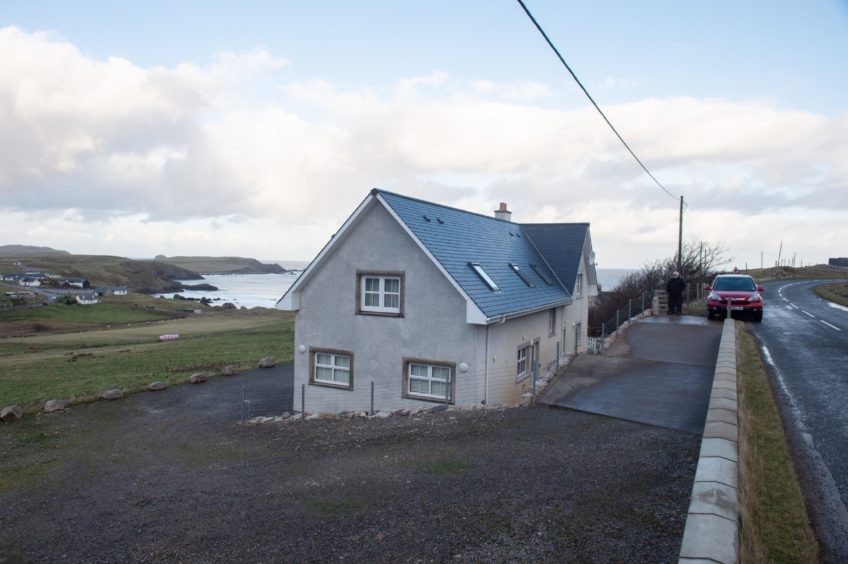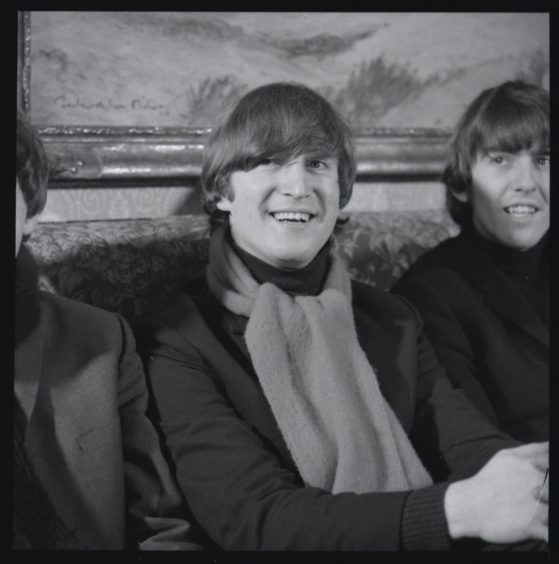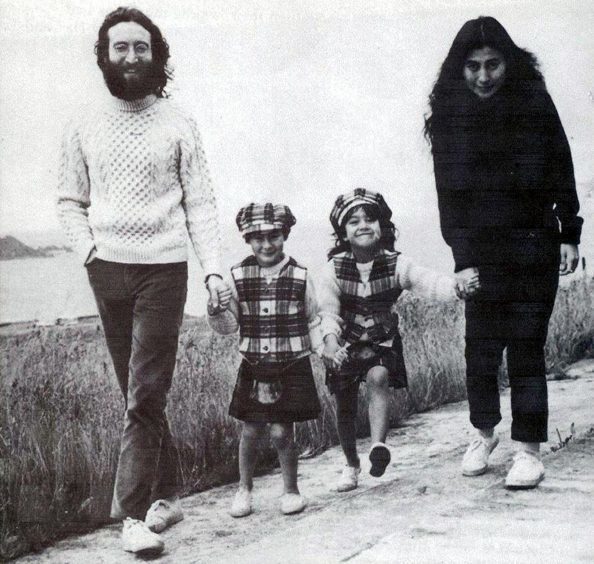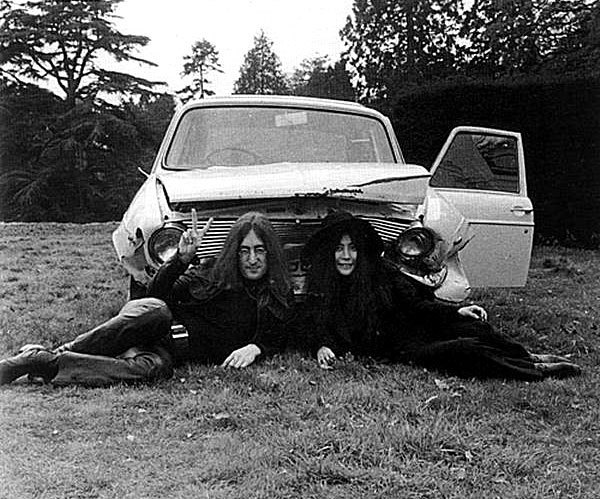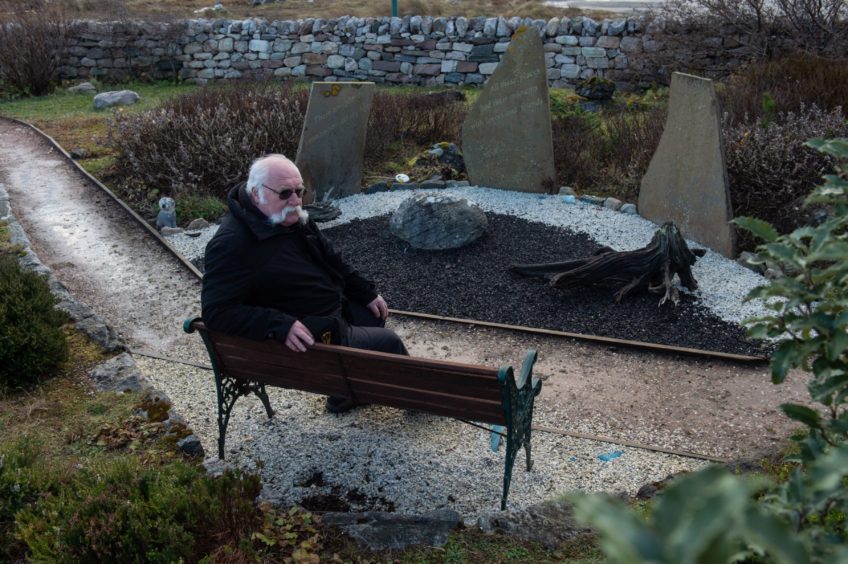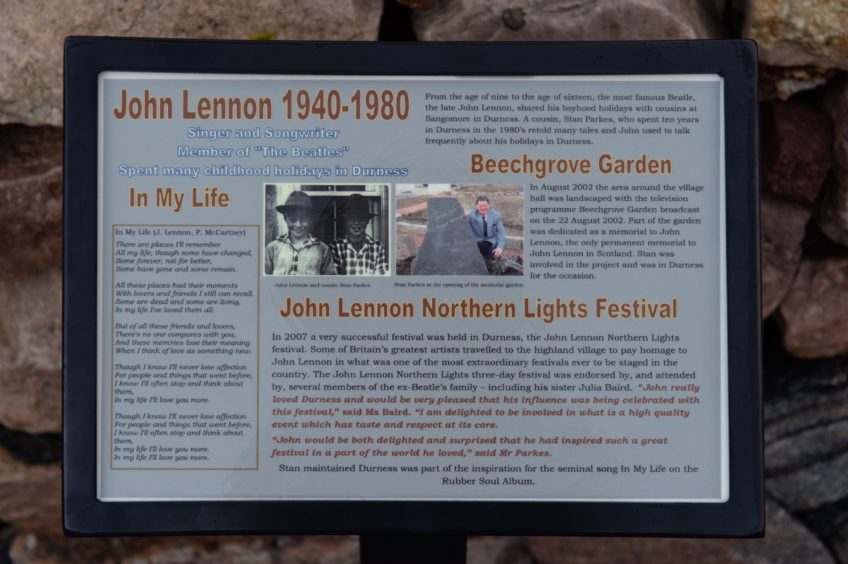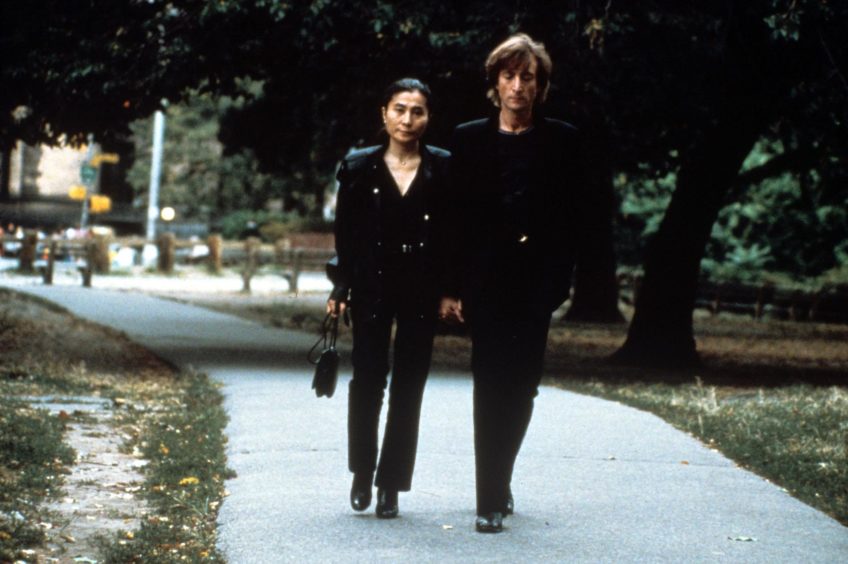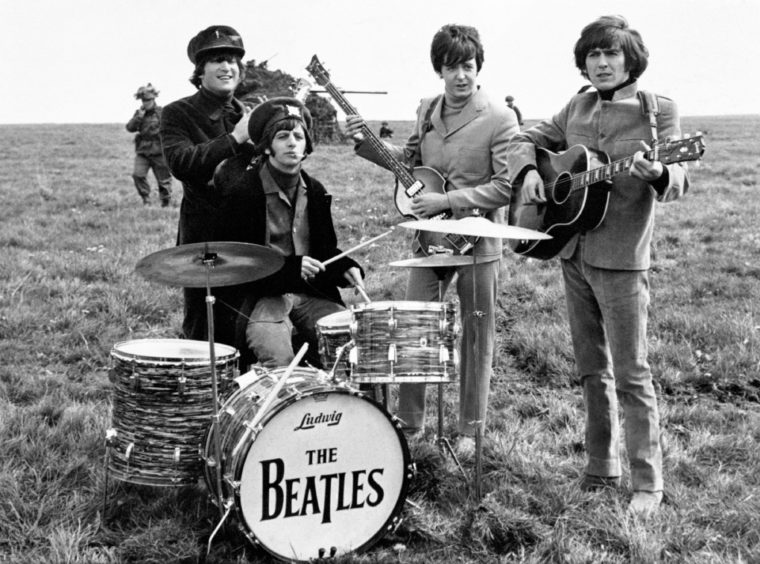There is a rugged beauty to the landscape around Durness, the little village of just 350 people, which lies on the north-west tip of Scotland.
The journey is hardly a magical mystery tour, presenting a long and winding road for any visitors and yet, long before he became one of pop history’s most exalted figures, John Lennon travelled here with his family and relished summers on the white sand beaches of Sango Bay and the mesmerisingly atmospheric surroundings of the nearby Smoo Cave.
Senseless act
It’s 40 years this week since the star’s murder at the hands of deranged fan Mark Chapman in New York; a senseless act which abruptly brought the curtain down on the former Beatle at the age of just 40 and dominated international news programmes for days afterwards.
Yet, while it might seem a world removed from the solitude of Durness to the hectic hubbub of the Big Apple, residents such as Donald Campbell still pay homage to Lennon at this time of year and recall how he loved the bagpipes, savoured his trips to Sutherland, and even talked about how he would have preferred to have been christened Jock than John.
There’s a plaque next door to Campbell’s property, which states simply: “John Lennon 1940-1980, Musician and Songwriter, lived here”.
And, on a cold winter’s day last week, he walked around the pristine memorial garden which has been created in the Liverpudlian’s honour.
Few people have delved deeper into the life and times of The Beatles than author and journalist Philip Norman, who followed up his acclaimed book about the Fab Four – Shout- with a comprehensive biography of Lennon, which extends to War and Peace proportions.
He talked about the impact which Durness and the rest of Scotland had on the youngster who spent so many vacations in a remote part of the Highlands.
Mr Norman said: “He got excited at the prospect of going on these journeys and it was a place to where he could escape and yet feel at home.
“He felt more Scottish than English and, growing up as he did in a polyglot city, he was comfortable on those holidays with his aunts and uncles and friends.
“He was always calling himself Jock and Whistling Jock Lennon and, even when he was living in New York, he was searching for a house that would remind him of the croft where he spent part of his childhood.
“It clearly meant a lot to him, because he didn’t only visit Durness when he was a child, but he returned in 1969 with Yoko Ono and their children and he wanted them all to see the same things he had enjoyed so much during his school years.”
Car crash
And, even if that escapade hit the buffers when Lennon was involved in a serious car crash, which consigned him to treatment in a hospital in Golspie, the experience didn’t dampen his enthusiasm or empathy for the people who lived a solitary existence in the far north.
On the contrary, he soaked up memories of days and nights spent in large family gatherings and also visited relatives in Edinburgh, loved the military Tattoo, marvelled at the American swing bands, and resolved he would make music in his own idiosyncratic fashion.
As Mr Norman added: “During the school holidays in 1956 (when he was 15), he paid a long visit to his Aunt Mater, Uncle Bert and cousin Stanley in Edinburgh, accompanied by Aunt Nanny, her nine-year-old son Michael and (Aunt) Harrie’s nine-year-old son David.
“Part of the time was spent at Uncle Bert’s croft in Durness – this was a working farm, set in vast, unspoiled tracts of sheep-dotted moorland and peat bogs.
“The family party roughed it up in a primitive farmhouse, lit by oil lamps and candles, and noisy with the screeches of Mater’s pet parrot, Harry Parry.”
Sutherland
They scythed hay, built dry stone walls and carted wheelbarrows full of sand.
But they also revelled in jaunts to the magnificent beaches in Sutherland, near Cape Wrath.
Lennon was immersed in all these endeavours and never forget about them.
Indeed, many believe the Beatles song In My Life talks directly about these halcyon days in Durness.
Once he joined forces with Paul McCartney and George Harrison, the Beatles – or Beetles as they were in the early stages – returned to Scotland in the early 1960s and began to develop the harmonies and the repertoire of songs which later became timeless classics.
But while Lennon was ready to pay his dues on an extensive tour of Scotland at the end of 1962 and beginning of 1963, encompassing myriad concerts in places such as Elgin, Dingwall and Bridge of Allan – in addition to their only appearance in Aberdeen at the Beach Ballroom – he and McCartney were dismayed by the dingy, down-at-heel nature of some of the venues.
Mr Norman, who has just released a new biography of Jimi Hendrix, said it was a familiar story for new groups to be booked into a relentless concert itinerary to satisfy promoters.
Caird Hall
He added: “The first Scottish tour was difficult for them and what they went through would have broken up many bands, often performing in front of just a few dozen people, while they were moving from one B&B to the next and receiving very little money.
“It was a different story when they returned at the end of 1964 to places such as Glasgow, Edinburgh and Dundee (and a packed Caird Hall).
“They were still full of energy and exuberance at that stage and they arrived on the scene at exactly the right time.
“America was reeling from the assassination of John F Kennedy and Britain has been rocked by the Profumo scandal. A lot of people were growing tired of the establishment and The Beatles offered something new: a sense of innocence and of working-class boys who produced terrific melodies with a smile on their face.”
In Durness, meanwhile, the locals who watched Top of the Pops recognised in Lennon the same mercurial individual who had thrived in their environs a decade earlier.
Short trousers
Mr Campbell can pinpoint exactly where the youngster travelled on his excursions.
He said: “I remember John running out of those gates and all of us racing to the beach. Just standing here brings back memories of short trousers and grazed knees.
“There was complete freedom for everybody in these days. All of us boys could run around the village talking to strangers and kicking a football and playing by the beach.
“It was totally safe and I can understand why it would have appealed to children who had grown up in big cities after the Second World War, where there were building sites and construction projects and ‘No Entry’ signs all over the place.
“There was none of that to worry about when John and others came to Durness.”
Tranquillity
That sense of tranquillity was painfully lacking during the acrimonious break-up of The Beatles at the end of a decade where they had established a reputation as the biggest band on the planet, if not perhaps – as Lennon infamously declared – bigger than Jesus.
Yet he discovered a new love in Yoko Ono and was determined to show her the sights and sounds from his teenage years. Which explained why, despite being a terrible driver, the couple and his son, Julian, and her daughter, Kyoko, set off for Durness in July 1969.
The roads around Golspie in Sutherland were narrow and hardly for novices, the weather was inclement, and Lennon panicked after spotting a foreign tourist heading towards him, quickly losing control of his Austin Maxi, as the vehicle plummeted into a ditch.
However, it was a misadventure which could have had a significantly worse outcome.
They were all taken to Golspie’s Lawson Memorial Hospital, where they were given stitches or treated for shock. Julian emerged almost unscathed and was taken to stay with his Aunt Mater in Durness, around 50 miles away, before his mother Cynthia escorted him back to London.
Lennon remained in hospital for five days, but he was not averse to speaking to reporters who turned up looking for interviews. As he cheekily remarked: “If you’re going to have a car crash, try to arrange for it to happen in the Highlands!”
Durness memorial garden stands as a tribute to the Beatles legend
Imagine there’s no heaven; it’s part of the lyrics of Lennon’s most famous solo composition.
But anybody who makes the effort to visit the memorial garden in his name in Durness will recognise that the pilgrimage to this shrine offers life-affirming rewards.
It is situated overlooking the precious expanse of sand on which the young boy had frolicked, oblivious to everything which lay in front of him.
And, at its centre are three slabs of granite into which have been etched a collection of lines from In My Life: Lennon’s poignant and evocative tribute to the “people and things that went before”.
Comfort
One recent visitor to the site, Alistair Kaye, from Stirling – this was in the days before Covid-19 – told me: “I think it’s interesting that both John and Paul found a lot of comfort from staying in out of the way places in Scotland.
“The garden is beautiful, but it’s understated. It doesn’t scream out: ‘This is for a superstar’. It’s the very opposite of that and it fits in with the rest of Durness.
“John Lennon would have liked it. That’s why so many of us make this pilgrimage every year.”
The legend lives on for all time
John Winston Ono Lennon MBE gained worldwide fame as the founder, co-lead vocalist, and rhythm guitarist of the Beatles.
His song-writing partnership with Paul McCartney remains the most successful in musical history.
In 1969, he started the Plastic Ono Band with his second wife, Yoko Ono. After the Beatles disbanded in 1970, Lennon continued a career as a solo artist and as Ono’s collaborator.
Liverpool
Born in Liverpool in 1940, the youngster initially became involved in the skiffle craze as a teenager. In 1956, he formed his first band, the Quarrymen, which evolved into the Beatles.
He was initially the group’s de facto leader, a role gradually ceded to McCartney. Lennon was characterised for the rebellious nature and acerbic wit in his music, writing, drawings, on film and in interviews. In the mid-1960s, he had two books published: In His Own Write and A Spaniard in the Works, both collections of nonsense writings and line drawings.
From 1968 to 1972, Lennon produced more than a dozen records with Ono, including a trilogy of avant-garde albums, his first solo LP John Lennon/Plastic Ono Band, and the international top 10 singles Give Peace a Chance, Instant Karma!, Imagine and Happy Xmas (War Is Over).
In 1975, he left the music business to raise his infant son Sean and, in 1980, returned with the Ono collaboration Double Fantasy.
He was shot and killed in the archway of his Manhattan apartment building by a Beatles fan, Mark David Chapman, three weeks after the album’s release.
As a performer, writer or co-writer, Lennon had 25 number one singles. Double Fantasy, his best-selling solo record, won the 1981 Grammy award for Album of the Year.
